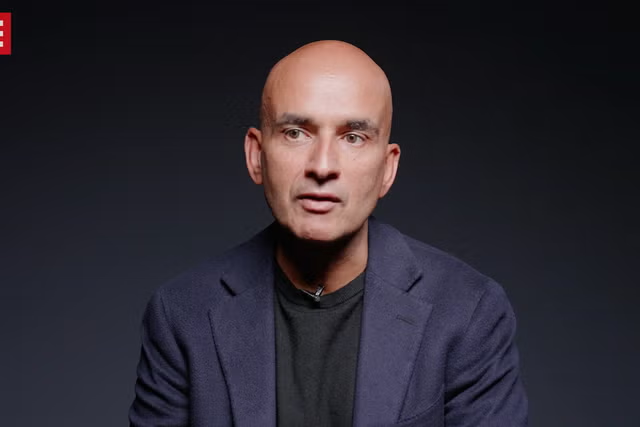Ten years ago, Julie was climbing Snowdon. Today, she can hardly walk without succumbing to excruciating pain or losing her balance.
The 46-year-old former bank teller first noticed something was wrong in 2018. She was constantly exhausted and would often get pins and needles.
“I thought I’d trapped a nerve or slept funny. Then I started to get really bad vertigo. That’s when I went to the GP and said ‘this isn’t right’. It took about a year to get diagnosed,” she says.
Julie was diagnosed with multiple sclerosis.
Her visit to the GP was the start of a long journey with many attempts to stay in work that ultimately failed.
“I’m in my mid-40s. I was expecting to work up until I was 60, maybe longer than that. If I was fit and healthy, I would be working full-time, I would be earning money, paying into my pension, and I would have been alright. But obviously that hasn’t happened,” she says.
Julie is one of the 2.8m Britons who are not working because of long-term sickness.
Roughly 700,000 more people have joined her on that list since lockdown, the equivalent of 400 people giving up on working life every day.
More worrying still is that almost all of the overall increase in worklessness since the pandemic, whether related to health or other factors, has been driven by British-born adults.
There are 833,000 more inactive British-born people of working age compared with 2020.
By comparison, the increase among EU-born workers is 57,000, while inactivity among those born outside the EU has risen by 219,000.
In total, there are 7.6m British-born people like Julie who are classed as economically inactive. Strip out those who are currently in college or university, and that still leaves 5m who are not working.
The rise also means the state is spending ever more money on them, with the bill to support people with disabilities or health conditions alone set to surge from £51bn before the pandemic to almost £80bn in real terms by the end of the decade.
Labour says it recognises the cost to the economy.
Jonathan Reynolds, the Business Secretary, told an audience at the Labour Party Conference that the cost of supporting these people, including the lost income from taxation, was “broadly £15bn a year. That is huge”.
The prize of turning that around is immense – enough to cut a penny off income tax and abolish the two-child benefit cap.
But getting people on benefits, especially those suffering ill health, back to work is notoriously difficult.
For a man who has previously been criticised for having a “soft touch” approach to benefits, can Sir Keir Starmer cure Britain’s sickness problem where others have failed?
‘Fixing the NHS won’t help me’
Sir Keir has said people like Julie who receive sickness benefits should be required to look for work, vowing to do “everything we can to tackle worklessness”.
He warned businesses last week that he will “not tolerate” a long-term failure to train workers in the UK, as part of his strategy to bring down migration.
He is backed by Lord Blunkett, the former home and education secretary, who believes a degree of “tough love” is needed to get people back to work.
This has to be led by a drive to get people back into the office, which he believes will particularly benefit young people, who missed out on so much interaction during lockdown.
The septuagenarian, who recently suffered a heart attack, is ready to lead by example.
“I think that this is one of the biggest challenges of the new Government, which is why I want [employers and employees] to exude optimism and hope rather than what I call miserableness because we need to re-energise the nation,” says Lord Blunkett.
“We’ve got to avoid being a tired country. And if I can feel re-energised after a heart attack, I really hope that we can engender that sense of momentum, drive and enthusiasm.”

But Julie – who had been working continuously before being diagnosed with MS – says the Prime Minister is underestimating the task.
She receives £184.30 per week in personal independence payments (PIP) for mobility and daily living expenses to help her cope with MS, and another £138.20 per week in Employment and Support Allowance (ESA) – a legacy benefit that used to be known as incapacity benefit.
She also receives some money from a work insurance scheme she had paid into when employed.
Liz Kendall, the Work and Pensions Secretary, pledged at the Labour conference to “bring in the biggest reforms to employment support in a generation”, signalling that this would be led by carrots instead of sticks.
“Job centres focusing on monitoring benefits” will be replaced by “a new jobs and careers service to help people get work and get on at work”, she said. Kendall added the Government would launch “new plans to join up support for work, health and skills so we tackle the root causes of worklessness”.
The Government this week announced people in areas with high levels of long-term sickness would get priority on NHS waiting lists.
But history suggests that even those who are actively seeking work have little hope of getting back in.
Analysis by the Office for Budget Responsibility (OBR) last year showed that only 650,000 of the 7.6m cases on an NHS waiting list were also economically inactive for health reasons.
The watchdog said this suggested that even halving waiting lists would only reduce working-age inactivity by around 25,000 in 2027-28.
Julie says that faster NHS treatment will do little to help people like her. “I’m not on any waiting lists. None of this sorting out the NHS and waiting lists would help me. There isn’t a lot that can help me really. It would be the same whether I’m in a workplace or if I’m working from home.”
Another Labour priority is getting young people back into work. Kendall warned last week that failure to get young people into work could result in a “lifelong cost” for “them and for the taxpayer”.
More than a third of working age unemployed people have been looking for work for more than six months. The prospects are even bleaker for people who have stopped looking.
Anita Charlesworth, a director at the Health Foundation and a former Treasury official, says early intervention is key.
“Acting early is really important. A lot of experts say that once someone’s been on sick leave for more than six weeks, the chances of getting back into work are very much reduced.”
Previous research has shown that only between 1pc and 2pc of people claiming benefits like Julie’s stop claiming benefits each month.
‘Work needs to pay’
Charlesworth says the stakes are higher for young people. “Back in the 1990s youth unemployment was the problem,” she says.
“Now we have an emerging problem of youth economic inactivity, and that’s something we should be deeply worried about, because we know from the past that if you’re not in work during that crucial period when you finish education, that has a long term effect on your pathway through adulthood, and that will come back to be a drag on economic growth for decades.”
Charlesworth, who recently joined the Government’s labour market advisory board addressing ill health in the workforce, says the situation among young people is critical.
“We’ve got more students and people learning new skills, which is obviously a good thing,” she adds. “But we’ve also got a rising issue of people finishing their education and not going into work.”
The statistics are stark. Analysis by Boston Consulting Group this month showed that students are one of the biggest groups signing themselves off after graduation, many for mental health conditions.
In 2021-22, more than 60,000 people aged between 16 and 24 went straight from being economically inactive because they were studying to being inactive through ill health. On a net basis – accounting for people flowing the other way – students pushed up inactivity numbers by 42,300.
Official statistics also show there are currently 872,000 young people who are neither in work, education nor training, with men driving the increase.
Alison McGovern, the employment minister, told a Labour fringe event that it was unacceptable that one in eight young Britons were “not doing anything”, with many left disillusioned by “politician bull—”.
Charlesworth says: “All the evidence is that we need to make sure that young people coming out of education get work quickly.”
The consequences are clear. There are now 2.7m people on Universal Credit alone who are not required to look for work. More than half of these people have been claiming these benefits for more than three years. Almost 700,000 have been parked on benefits without work requirements for more than five years.
Workless Britons are piling more pressure on the public finances.
Recent OBR analysis shows that a typical UK-born person costs taxpayers £400,000 each by the time they reach adulthood as the cost of free prescriptions, education, the NHS and dental care adds up.
For those on the average wage throughout their lives, it is not until they reach 47 that they have paid more into the system than they have taken out, with the average person paying £270,000 more in taxes than they have taken from the state by the time they reach state pension age. A life on benefits means millions of Britons may never contribute to society.
There is a handsome fiscal reward for getting these people back to work. The OBR’s analysis also found that every person who gets a job after a spell of economic inactivity saves the state up to £15,300 in benefit payments.
Charlesworth is clear what the incentives need to be: “Work needs to pay. If you’re better off out of work and you’re on a lower income, however much you want to work, you’re not going to work.”
Labour is edging towards a modern version of the New Deal of the 1990s to try to tackle youth worklessness.
Funded by a £5bn windfall tax on privatised utilities, The British New Deal for Young People began in January 1998.
The government-subsidised scheme offered youngsters who had been unemployed for six months or more extra help looking for work or an opportunity to take part in training schemes without losing benefits.
While expensive, the programme was deemed a success, even though it was rolled out against a favourable economic backdrop.
Kendall actually worked on the programme as an adviser to Harriett Harman when she became work and pensions secretary.

Lord Blunkett, who was also in government at the time, remembers the hostility among some ministers at the conditionality of the scheme, which did not give young people the option to turn down a training opportunity.
“I attended meetings where people were silent or where in some cases cabinet ministers booed. But we did make progress.
“There will always be resistance to the idea there has to be ‘something for something’. But the alternative is that we write people off, and that then has an intergenerational impact.”
Lord Blunkett, who now leads the programme UK Year of Service, which places 18 to 24-year-olds in paid jobs, says there has to be more emphasis on letting young people try jobs without “losing their benefits immediately”.
He adds: “If the job doesn’t work out, we’ve got to supply that kind of security and confidence. But in the end, the world doesn’t owe any of us a living.”
Risks for employers
Paul De Savary is the managing director of Home From Home Care, which runs 11 specialist care homes in Lincolnshire for adults with learning difficulties and highly complex needs.
It is an industry that has become notorious for labour shortages, and it is bosses like him that Sir Keir wants to help.
But over the years De Savary has heard many prime ministers suggest the sector should take on more staff who are currently on sickness benefits.
That in itself is more complicated than politicians often let on, he warns.
“It’s a very skilled job although nobody recognises that. There is a requirement for punctuality and reliability generally because people rely on you. You can’t not just turn up,” he says.
This means that accommodating a worker struggling with their own physical or mental health who may experience sudden flare-ups can be difficult.
“This is the type of issue where you’re asking somebody who needs quite a lot of support themselves to provide support to people who need a great deal of it,” says De Savary.
“There is a basic level of expectation and if you can’t meet that, however complex your needs are and however justified they might be, it just doesn’t work in care where you’re responsible for somebody else’s life.”
Many applicants he sees have challenges around their physical or mental health.
“Especially when you have a tight labour market, the people who have not found the ‘sexy’ jobs, as they look at it, end up coming through our door,” he says.
However, some people he has taken a chance on have been “fantastic”, he says. The crucial thing is that people are able to put the patients’ needs first.
“You really do get that lived experience of I know what it’s like to feel depressed, anxious, whatever it might be. It creates a unique awareness and empathy,” he says.
Sir Keir’s Government has pledged the biggest shake-up of workers’ rights in a generation within 100 days in power.
While it is yet to set out the details, pledges include boosting sick pay, banning zero-hour contracts and giving unions more power.
A centre-piece of the New Deal for Working People is handing workers day-one rights.
Employees currently need to work somewhere for two years before they can sue their employer for unfair dismissal, but this period will likely be scrapped.
Both the Chancellor and the Business Secretary insist employers can still use probation periods and lay off workers “if it doesn’t work out”, but experts warn it is uncertain how this would work in practice.
Hiring someone with health challenges comes with an inherent risk, De Savary says.
He fears that the Government’s plans to strengthen employment rights while also trying to get long-term sick people back into work will backfire, making employers more risk-averse.
“You are already taking a £3,000 to £4,000 chance on a person in the first two weeks – to pay for them to turn up, their training and the recruitment process,” De Savary says.
“If they’re going to have employment rights from day one or pretty much thereafter, you’re not going to take the risk in the same way. You can’t afford to,” he says.
Charlesworth agrees that policymakers need to be mindful of “de-risking that transition to work”, for both individuals and employers.
She adds: “Obviously big employers have a lot of the HR expertise and access to things that enable them to do that. But how do you help small and medium sized employers feel that actually they can have a go with somebody and it won’t blow up in their face?
“But also for individuals, often it takes a long time to get your package of benefits in place, and you are very frightened about putting all of that at risk.”
Underpinning all of this is a desire to save money. “The DWP tends to just want lots of shiny new employment programmes,” says one former Tory official.
“A big win for us was persuading the OBR that we would ‘score’ employment impacts from our policies, because that means they can to an extent pay for themselves.”
The Treasury also likes policies that focus on conditions that “deliver tangible savings from the benefits bill”.
This is because at the heart of everything is a “scorecard” that determines how much policies cost or save at each fiscal event.
Cutting the benefits bill
Questions remain over whether Labour will scrap reforms introduced by the Tories related to the so-called work capability assessment that determines people’s benefits and whether they need to engage with the job centre.
A Labour source said “nothing has been decided”, although scrapping the reforms means the Government will have to plug a £3bn hole in the public finances.
“The Treasury loves benefits overhauls, because it delivers direct savings that the OBR can score, whereas stuff that is a bit fluffier about changing the structure of job centres and the stuff that Labour is talking about is a lot harder to quantify [than] a benefit that is meaningful, because ultimately the Treasury just cares about money.”
Other Tories are sceptical that Labour will even want to have a conversation about reducing benefits.
“There’s never going to be an easy way to say to someone who for maybe a decade or more has never had to even have a conversation with the job centre,” says another Tory official. “It’s never going to go down well. So they’re going to have to be willing to have a fight, basically.”
Lord Blunkett says reform of the system is critical for the economy.
He also disagrees with Jonathan Reynolds that working from home is a universal benefit. Instead he urges more companies to get employees back to the office.
“Socialisation and teamwork and the motivation that goes with it feed off each other,” adds Lord Blunkett. “Certainly I tried to get back into the rhythm of what I was doing as quickly as possible after the first Covid lockdown, simply because I felt that I was losing that energy and that drive.”
Lord Blunkett believes working from home should be reserved for people with the most severe disabilities.
“As for what Johnny [Reynolds] was saying, that applies to people who mustn’t be written off because they’ve got a severe disability or a long term sickness problem.
“For the rest of us – and I count myself in this – we do need encouragement to be able to get out and to re-engage, because talking to people on Zoom or Teams is not the same thing as being in the same room, sharing ideas and innovation, that’s what we need to do.
“It’s about creating a work ethic and getting up in the morning and holding a job down.”
Some in Tory circles are thinking about how to get tougher on benefits.
Former chancellor George Osborne arguably took the toughest approach possible by freezing working age benefits in cash terms for four years, saving £4bn, as well as introducing the two-child limit that many in Labour would like to abolish.
The rising child disability benefits bill is one option. “I tried to suggest that but it was blocked,” says one Tory source. The bill is on course to rise to £5.8bn by the end of the decade
Meanwhile, Julie has a message for the Prime Minister: “They need to look into this a lot more deeply and actually speak to people like me.”
The news about looming cuts to disability benefits has made her feel anxious about not being able to afford her bills and mortgage.
“I find it hard self-confidence-wise because I don’t feel I’m contributing. I have contributed obviously, I’ve worked all my life up until that point.
“So I keep remembering that. But saying what they’re saying, it makes you feel bad about yourself. It doesn’t do much for the old confidence, unfortunately,” she says.
“But it is what it is. I just get on with it. Try to concentrate on what I can do. Because otherwise you just tie yourself up in knots and it makes you depressed.”
Disclaimer: The copyright of this article belongs to the original author. Reposting this article is solely for the purpose of information dissemination and does not constitute any investment advice. If there is any infringement, please contact us immediately. We will make corrections or deletions as necessary. Thank you.



